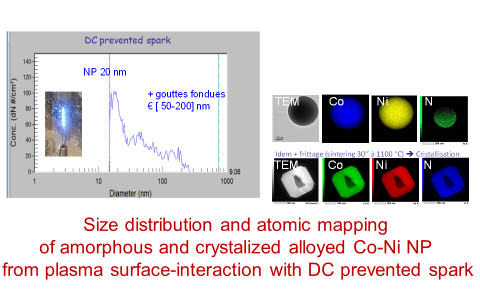Ex.1 TAYLORED NANOPARTICLE SYNTHESIS (COMPO, SIZE, STRUCTURE) VERSUS PLASMA CONDITIONS OF FORMATION WITH DIFFERENT PLASMA FILAMENTS (MICRO-DISCHARGE IN DBD, STREAMER,SPARK IN CORONA)
CONTACT : JEAN-PASCAL BORRA
Plasma-based aerosol processes for catalytic properties of multi-Metal nanoparticles (NP)
Nucleation in plasmas is a long term topic of LPGP depicted in [14, 18, 19, 20, 24, 26, 31, 40, 44, T14, T15, T27, T30, T31, T33, T34].
Atmospheric pressure Plasma in nitrogen and air are confined in time and space, as plasma filaments lasting a few ns, from tens to few micrometers in diameter. The production of condensable species and nucleation necessarily occurs either from cooling of expanding vapor plumes produced by plasma-surface interaction, depicted just below, or from injection of gaseous precursors in the plasma for reactive nucleation (cf. Ex.2,).
Tuning plasma properties, like energy per filament and dynamic of energy deposition on surfaces, is a simple way to control the conditions of NP synthesis and related properties.
Indeed, NP are formed by condensation (or nucleation) of hot vapors in expanding vapors jets/clouds from the electrodes (Mo, W, Al, Fe, Ni, Cu, Sn, Zn, Au, Ag, Pt) and from dielectric material (alumina).
We confirmed this mechanism with different alloyed electrodes with IJL-Nancy. However, core-shell NP of Cu@ZnO are produced from Cu-Zn alloys, while alloyed Co-Ni NP are synthesized in similar plasma conditions from Co-Ni alloys.

Going one step further, the effect of cooling rates of expanding vapor jets on the structure of nanoparticules, is under investigation to select plasma operating conditions (controlling the filaments electro-thermal properties) versus targeted composition and structure of NP. Metastable multi-Metal crystal structures are expected with respect to cooling rates in prevented spark, typical of those required for high entropy alloys formation (over 105 K.s-1). The goal is to control optical properties, like UV photoemission and catalytic properties of multi-Metal nanoparticles.
Laboratoire de Physique des Gaz et des Plasmas
Bat 210, rue Henri Becquerel
91405 Orsay Cedex
Tél : (33) 01 69 15 72 51
RÉSEAUX SOCIAUX


